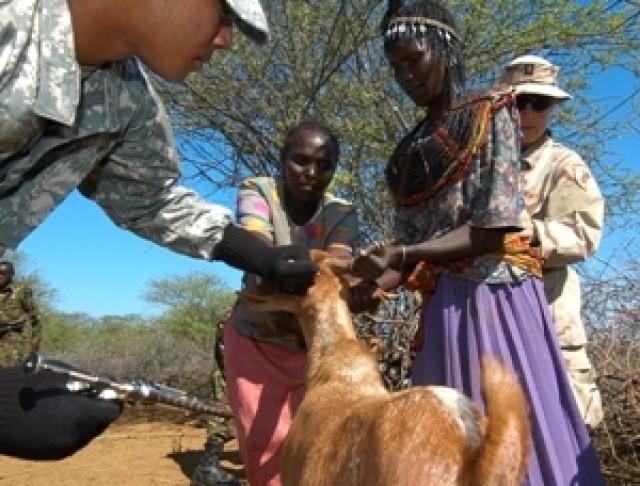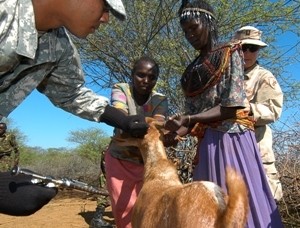
NGINYANG, Kenya - This story begins with the E Company/96th Civil Affairs Civic Action Team* at the base of an isolated livestock watering hole in the Northern Rift Valley Province of Kenya. The heat of the day was starting to make an appearance rapidly through the dry dust kicked up by the arrival of our vehicle convoy. In what looked like the middle of a lunar landscape (no cellular phone coverage here, folks), a livestock watering hole sprouted, protected by a berm and formidable cactus bushes. <br/><br/>As the team, along with East African Community (EAC) soldiers and locals, closed in at the foot of the watering hole they encountered herds and herds of goats and sheep already being led in an organized fashion towards two holding pens. The circular holding pens were nothing more than neatly arranged tree and thorn bush branches allowing a herd of about 150 goats and sheep to be comfortably confined. The tribal leader of these nomadic people whom the team had coordinated with several days earlier had certainly spread the word about the upcoming VETCAP. News travels fast even by word of mouth! <br/><br/>VETCAP stands for Veterinary Civic Action Program, which is a special form of Humanitarian Assistance (HA) called Humanitarian and Civic Assistance (HCA). HCA is assistance provided to the local populace by predominantly U.S. forces in conjunction with military operations, such as the Exercise Natural Fire 2006, in which this particular VETCAP was supporting. <br/><br/>Guidance from local Kenyan veterinary health officials recommended that the VETCAP concentrate on vaccinating sheep and goats for sheeppox and goatpox (Pox) and goats for Contagious Caprine Pleuropnemonia (CCPP). The poxviruses are serious and often-fatal diseases characterized by skin eruptions (somewhat similar to smallpox in humans). In addition the team also treated several animals presented on sick call. The vets ended up setting a fractured left forelimb in a goat and cleaning an infected facial wound in a lamb.<br/><br/>The Civic Action Team, along with the EAC and local people, split up into groups: a preparation center (mixing and drawing up vaccines) and two animal teams each consisting of two vaccinators (one for Pox and one for CCPP), one "marker" and three handlers. The animal teams then gathered in a corral and started the process. One after another each animal was collected and restrained by a handler, vaccinated, marked on the head with a non-toxic, long-lasting paint stick in either blue or green (to prevent re-vaccinations) and finally released outside of the corral. This went on for most of the day. As one herd of animals was completed another herd would materialize out of the bush and the team would start all over again. Overall, more than 2000 animals were treated. Not a bad day for a Civil Affairs Civic Action Team!<br/><br/>The Civic Action Team was made up of one U.S. Air Force physician, one U.S. Army veterinarian, one U.S. Army Reserve veterinarian and one U.S. Army Reserve animal care provider.

Social Sharing